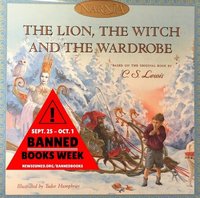Book Bans Bump Up Against First Amendment
Students may be surprised to learn that some popular books have been the target of banning efforts. Maurice Sendak's "Where the Wild Things Are" and J.K. Rowlings's Harry Potter series are but two of hundreds of books that some school boards, community members, or parents have tried to keep children from reading.

What do “Where the Wild Things Are” by Maurice Sendak, “A Light in the Attic” by Shel Silverstein, “The Lion, the Witch and the Wardrobe” by C.S. Lewis, and the Harry Potter book series by J.K. Rowling have in common? Their fantastical capacity to spark the imagination? Their legions of devoted fans?
Perhaps, but Banned Books Week (Sept. 25–Oct. 1 this year) reminds us that these books have another feature in common: They have all appeared not only on best-seller lists but also on banned books lists. Their wrongdoings, according to critics, range from supporting witchcraft and the supernatural to condoning messiness and disobedience, spurring children to such mischievous acts as breaking dishes and throwing temper tantrums.
These are just a few of the many books that some school boards, community members, and parents have tried — sometimes successfully — to remove from school library shelves and classrooms. Indeed, ongoing attempts to ban some books in school, as elsewhere, are nothing new. Banning or challenging books is about as old as books themselves. But restrictions on access to books run up against the First Amendment.
For example, the Supreme Court endorsed the idea that the First Amendment contains protections against the removal of books from school libraries based on their content in its 1982 ruling in Board of Education v. Pico. “Local school boards may not remove books from school library shelves simply because they dislike the ideas contained in those books,” the court wrote, according to a story by the Newseum Institute’s First Amendment Center.
To educate elementary school children about the First Amendment’s protection of free expression and the harmful effects of censorship, NewseumED.org offers two age-appropriate learning experiences: a matching game and a mural activity that teachers can download. In the matching game, students match examples of banned children’s books with the often surprising reasons for their banning. In the mural game, young learners are divided into two groups, one of which has the freedom to create a multicolored mural about any aspects of going to school that they wish to depict, while the other must use black, brown or gray colors to show only those school scenes deemed appropriate by a censor.
VIEW THE NEWSEUMED LESSON
NewseumED’s matching game and mural activity are two of the many ways to celebrate Banned Books Week. The American Library Association’s annual Banned Books Week “brings together the entire book community; librarians, booksellers, publishers, journalists, teachers, and readers of all types, in shared support of the freedom to seek and to express ideas, even those some consider unorthodox or unpopular.”
Banned Books Week is sponsored by the American Booksellers Association; American Library Association; American Society of Journalists and Authors; Association of American Publishers; Author’s Guild; Comic Book Legal Defense Fund; Dramatists Legal Defense Fund; Freedom to Read Foundation; National Coalition Against Censorship; National Council of Teachers of English; People for the American Way; PEN America and Project Censored. It is endorsed by the Center for the Book in the Library of Congress.